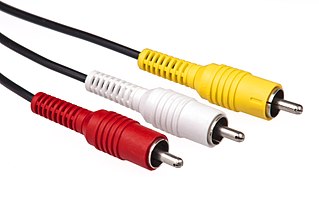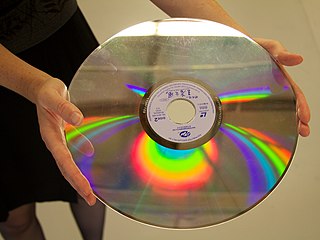
The VHS is a standard for consumer-level analog video recording on tape cassettes, introduced in 1976 by the Victor Company of Japan (JVC). It was the dominant home video format throughout the tape media period in the late 1970s, 1980s, and 1990s.

SCART is a French-originated standard and associated 21-pin connector for connecting audio-visual (AV) equipment. The name SCART comes from Syndicat des Constructeurs d'Appareils Radiorécepteurs et Téléviseurs, "Radio and Television Receiver Manufacturers' Association", the French organisation that created the connector in the mid-1970s. The related European standard EN 50049 was refined and published in 1978 by CENELEC, calling it péritelevision, but it is commonly called by the abbreviation péritel in French.

The RCA connector is a type of electrical connector commonly used to carry audio and video signals. The name RCA derives from the company Radio Corporation of America, which introduced the design in the 1930s. The connector’s male plug and female jack are called RCA plug and RCA jack.

S-VHS (スーパー・ヴィエイチエス), the common initialism for Super VHS, is an improved version of the VHS standard for consumer-level video recording. Victor Company of Japan introduced S-VHS in Japan in April 1987, with their JVC-branded HR-S7000 VCR, and in certain overseas markets soon afterward. By the end of 1987, the first S-VHS VCR models from other competitors included the Hitachi VT-2700A, Mitsubishi HS-423UR, Panasonic PV-S4764, RCA VPT-695HF, and Toshiba SV-950. It has been standardized as IEC 60774-3 and IEC 60774-4.
A DVD player is a device that plays DVDs produced under both the DVD-Video and DVD-Audio technical standards, two different and incompatible standards. Some DVD players will also play audio CDs. DVD players are connected to a television to watch the DVD content, which could be a movie, a recorded TV show, or other content.

A home cinema, also called a home theater or theater room, is a home entertainment audio-visual system that seeks to reproduce a movie theater experience and mood using consumer electronics-grade video and audio equipment and is set up in a room or backyard of a private home. Some studies show that films are rated better and generate more intense emotions when watched in a movie theater, but convenience is a major appeal for home cinemas. In the 1980s, home cinemas typically consisted of a movie pre-recorded on a LaserDisc or VHS tape; a LaserDisc Player or VCR; and a heavy, bulky large-screen cathode-ray tube TV set, although sometimes CRT projectors were used instead. In the 2000s, technological innovations in sound systems, video player equipment, TV screens and video projectors have changed the equipment used in home cinema set-ups and enabled home users to experience a higher-resolution screen image, improved sound quality and components that offer users more options. The development of Internet-based subscription services means that 2020s-era home theatre users do not have to commute to a video rental store as was common in the 1980s and 1990s.

Betamax is a consumer-level analog recording and cassette format of magnetic tape for video, commonly known as a video cassette recorder. It was developed by Sony and was released in Japan on May 10, 1975, followed by the US in November of the same year.

The LaserDisc (LD) is a home video format and the first commercial optical disc storage medium, initially licensed, sold and marketed as MCA DiscoVision in the United States in 1978. Its diameter typically spans 30 cm (12 in). Unlike most optical-disc standards, LaserDisc is not fully digital, and instead requires the use of analog video signals.

A camcorder is a self-contained portable electronic device with video and recording as its primary function. It is typically equipped with an articulating screen mounted on the left side, a belt to facilitate holding on the right side, hot-swappable battery facing towards the user, hot-swappable recording media, and an internally contained quiet optical zoom lens.

The videotape format war was a period of competition or "format war" of incompatible models of consumer-level analog video videocassette and video cassette recorders (VCR) in the late 1970s and the 1980s, mainly involving the Betamax and Video Home System (VHS) formats. VHS ultimately emerged as the preeminent format.

The 8mm video format refers informally to three related videocassette formats. These are the original Video8 format and its improved successor Hi8, as well as a more recent digital recording format known as Digital8. Their user base consisted mainly of amateur camcorder users, although they also saw important use in the professional television production field.
A DVD recorder is an optical disc recorder that uses optical disc recording technologies to digitally record analog or digital signals onto blank writable DVD media. Such devices are available as either installable drives for computers or as standalone components for use in television studios or home theater systems.

D-VHS is a digital video recording format developed by JVC, in collaboration with Hitachi, Matsushita, and Philips. The "D" in D-VHS originally stood for "Data", but JVC renamed the format as "Digital VHS". Released in December 1997, it uses the same physical cassette format and recording mechanism as S-VHS, but requires higher-quality and more expensive tapes and is capable of recording and displaying both standard-definition and high-definition content. The content data format is in MPEG transport stream, the same data format used for most digital television applications. It used MPEG-2 encoding and was standarized as IEC 60774-5.
Neuros Technology was a Chicago, Illinois–based company that produced a number of audio and video devices under the brand name Neuros. Founded by Joe Born in 2001 as a division of Digital Innovations, it previously operated under the name Neuros Audio. Like Digital Innovations, Neuros distinguished itself by its use of open-innovation and crowdsourcing techniques to bring products to market, as well as by its prominent use of open-source software and open-source hardware. In its development model, end users were involved throughout the product development process from reviewing initial concepts to beta testing initial product releases.

A home theater in a box (HTIB) is an integrated home theater package which "bundles" together a combination DVD or Blu-ray player, a multi-channel amplifier, speaker wires, connection cables, a remote control, a set of five or more surround sound speakers and a low-frequency subwoofer cabinet. Manufacturers also have come out with the "soundbar", an all in one device to put underneath the television and that contains all the speakers in one unit.
The Analog Protection System (APS), also known as Analog Copy Protection (ACP), Copyguard or Macrovision, is a VHS and DVD copy protection system originally developed by the Macrovision Corporation. Video tapes copied from DVDs encoded with APS become garbled and unwatchable. The process works by adding pulses to analog video signals to negatively impact the AGC circuit of a recording device. In digital devices, changes to the analog video signal are created by a chip that converts the digital video to analog within the device. In DVD players, trigger bits are created during DVD authoring to inform the APS that it should be applied to DVD players' analog outputs or analog video outputs on a PC while playing back a protected DVD-Video disc. In set top boxes trigger bits are incorporated into Conditional Access Entitlement Control Messages (ECM) in the stream delivered to the STB.

The Sony BDP-S1 is a first generation Blu-ray Disc (BD) player and is the first such player released in North America. It was originally scheduled for release in the United States on August 18, 2006 with a MSRP of $999.95. Sony had postponed the release date of this player several times and it was released on December 4, 2006.

An audio/video receiver (AVR) or a stereo receiver is a consumer electronics component used in a home theater or hi-fi system. Its purpose is to receive audio and video signals from a number of sources, and to process them and provide power amplifiers to drive loudspeakers, and/or route the video to displays such as a television, monitor or video projector. Inputs may come from a TV, FM, or AM tuner, satellite receiver, DVD players, Blu-ray Disc players, VCRs or video game consoles, among others. The AVR source selection and settings such as volume, are typically set by a remote controller.

A videocassette recorder (VCR) or video recorder is an electromechanical device that records analog audio and analog video from broadcast television or other AV sources and can play back the recording after rewinding. The use of a VCR to record a television program to play back at a more convenient time is commonly referred to as time shifting. VCRs can also play back prerecorded tapes, which were widely available for purchase and rental starting in the 80s and 90s, most popularly in the VHS videocassette format. Blank tapes were sold to make recordings.
A VCR/Blu-ray combo is a multiplex or converged device, convenient for consumers who wish to use both VHS tapes and the newer high-definition Blu-ray Disc technology.















